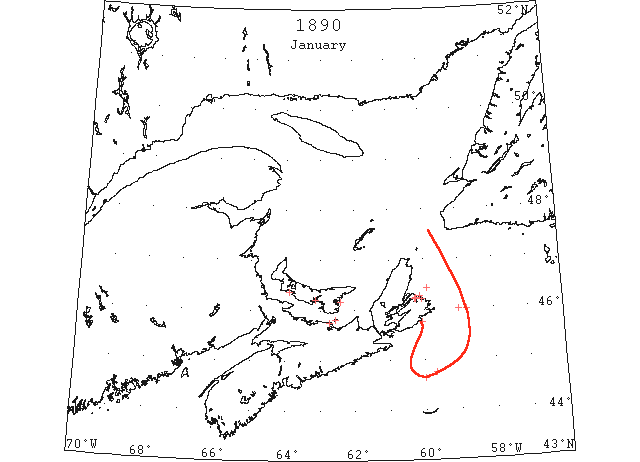
Jan 4 There is crossing on the ice at Bedeque and other harbours, though the Hillsborough is still open. (Pat 4 Jan p3#1)
Jan 6 The ferry boat has ceased running as the ice is strong enough for crossing on foot. (Pat 6 Jan p3#1)
Jan 14 North Sydney closed. (LL)
Jan 15 SS “St. Pierre” could not get in to Sydney, CB, on account of ice. She also passed a quantity of ice in the gulf on her way across from St. Pierre. (HB #20 Jan 17)
Jan 23 Low Point, CB, there is some light ice off to-day, but no drift or heavy ice has yet been sighted. (MH 23/01/1890 p3#6)
Jan 23 The Halifax Chronicle of Thursday morning says: Owing to the harbour of St. John’s and coast of Newfoundland being blocked with the ice the steamer “Circassian” is unable to leave for this port. She will sail as soon as the wind changes and moves the ice off. (Pat 25 Jan p3#1)
Jan 24 Steamer “Lydian Monarch” (Br), at Halifax, when off Newfoundland, passed a quantity of field ice and a number of huge icebergs. (NYMR, p.2, col.3).
Jan 25 The steamer “Caspian”, on her way to St. John’s from Halifax, reached Cape Race Thursday morning and endeavored to push through, but the ice was too heavy for her. She had to proceed to Liverpool with our mails and passengers. Steamer “Circassian” is still blockaded, waiting till the ice moves off. (NYMR, p.2, col.3)
Jan 25 The “Stanley” was eight hours reaching Pictou on Saturday; heavy ice nearly all the way. The heaviest ice of the season was met with and overcome on Saturday without accident. (Pat 27 Jan p3#1)
Jan 27 Am. Schooner “Centennial”, 30 miles E of Scatari heavy field ice extending beyond view. Also met some 20 miles W of Scatari to clear which we had to run S. (HB #23 Feb 7)
Jan 28 Low Point, CB, the barque “Carpasian,” which passed yesterday, is caught in the ice off Lingan head, about four miles south east from here. The strong north east gale of last night caused the ice to pack and carried the vessel to within one-fourth of a mile from the shore. We had communication with her by signal during the day, and her position is not very dangerous, as the ice is packed closely, and will prevent her from coming nearer the shore. Several persons walked to her on the ice, which is very strong. The weather today had been very fine and clear, with a moderate breeze [?] of north wind. The ice is light, close packed, and stationary as far as can be seen. (MH 24/01/1890 p3 #1)
Jan 28 North Sydney, CB, the barque “Carpasian,” reported in a dangerous position off Lingan Head, had got clear of the ice and has proceeded on her voyage. The schooner “Pioneer,” bound for the Newfoundland seal fisheries, is still ice bound off Sydney mines. (MH 29/01/1890 p3 #2)
Jan 29 At 4 o’clock this afternoon, word was received here that the “Stanley” was five miles from Georgetown, working her way through the ice to that port. (Pat 29 Jan p3#1)
Jan 30 Schooner “Porter S. Roberts” reports heavy field ice in the Gulf of St. Lawrence which must have come down the gulf, none having rounded Cape Ray as yet. The schooner “M.C. McGowan” also reports heavy drift ice 40 miles E of Scatari extending beyond view. Last winter, they [Gloucester fishermen] met none of any consequence in the gulf. (HB #23 Feb 7)
Jan 30 SS “Stanley” from Pictou for Charlottetown is fast in the ice 5 miles from Pictou. (HB #23 Feb 7)
Jan 31 SS “Colina” 44°38’N 60°00’W numerous streaks of field ice with a few large pieces. (HB #23 Feb 7)
Jan 31 SS “Washington City” ran into a field of heavy ice 44°45’N 59°42’W in which it remained till 5 am. (HB #24 Feb 14)
Jan 31 The “Stanley”: Mails and passengers landed last evening and would leave for the Capes at 7 am today. It is unlikely that any outside mails can reach PEI before tomorrow noon. The Ship still remains ice-bound. (Pat 31 Jan p3#1)
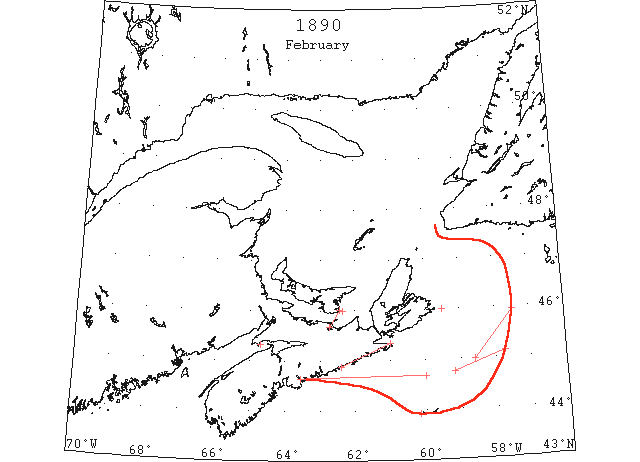
Feb 3 Schooner “Centennial” from Fortune Bay, NF, at Gloucester reports meeting in the Gulf, 30m east of Scatary, heavy field ice extending beyond view. (NYMR)
Feb 3 The Furness line steamer “Washington City”, from Hamburg, January 5th, via Portland, E, 25 days from the latter port, arrived in Halifax yesterday morning. When the steamer ran short of coal she bore up for Sydney, but met so much ice on the Cape Breton coast that she proceeded for this port. Drift ice was encountered from Canso to Beaver Island light. (MH 03/02/1890 p3#2)
Feb 6-7 SS “St. Pierre”, 70 miles WSW mag. From Gallantry Head (Miq.) fell in with ice 18 inches out of the water with numerous blocks 3 to 4 feet out of the water. The ice was in large patches of about 2 miles in width, E and W. Cleared the ice the following day 145 miles WSW mag. From Gallantry Head. (HB #25 Feb 21)
Feb 7 Canso, schr “Herbert M Rogers” (Am.) from Gloucester bound to Fortune Bay, Nfld, reports met heavy ice off Scatterie and was unable to get through or around it. (MH 08/02/1890 p3 #5)
Feb 12-14 Brig “Caroline” from Fortune Bay to Boston encountered and imprisoned in heavy field ice and damaged. (NYMR)
Feb 12-14 Brig “Caroline” 43°55’N 60°10’W in field ice and damaged. (HR).
Feb 22 SS “Conscript” There is an immense field of heavy pack ice between Miquelon and Cape Breton. We cut through more than 100 miles of this ice, which was between 1 and 2 feet thick and stripped the sheathing from the bow. (HB #26 Feb 28)
Feb 22 SS “Conscript” from St. John’s to Halifax stripped sheathing from her bows in heavy field ice [passed through 200m of field ice]. (HR)
Feb 22 The “Stanley” left Georgetown at 5 am. she proceeded about a mile beyond Cape Bear when, owing to the thick weather, heavy ice, and no open water in sight, she was obliged to return, reaching Georgetown at 1 o’clock pm. (Pat 22 Feb p3#1)
Feb 24 The “Stanley” left Georgetown at 6 o’clock this morning. She arrived at Pictou this afternoon. The Captain reports the straits full of ice and the crossing very uncertain. She will probably return tomorrow. (Pat 24 Feb p3#1)
Feb 26 A telegram from St. John, NB, states that the schooner “Swallow” from that Port Feb. 23 for Parrsboro, is caught in the ice at Spencer’s Island. Tug will go to help her. (HB #27 Mar 7)
Feb 28-Mar 2 Light slab [sic] ice from Halifax to 44°40’N 60°W; 44°45’N 59°10’W to 45°8’N 57°43’W heavy Gulf ice [causing vessel to stop several times; speed through the ice about 3 knots (HB)]; 45°35’N 55°15’W rotten field ice. (MWR).
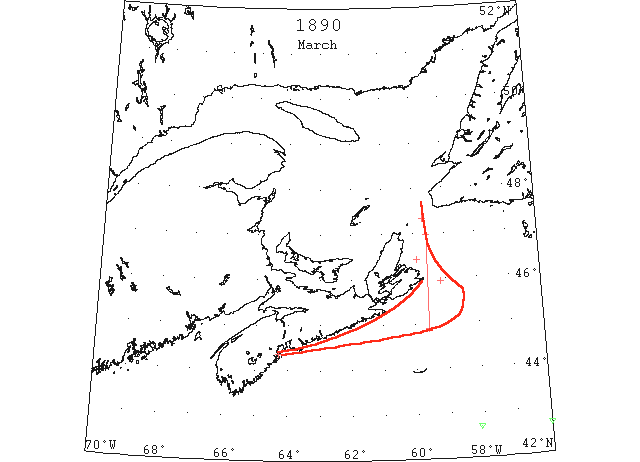
Mar 4 The Gulf of St. Lawrence is blocked and this season is the heaviest one for ice since 1882; (MWR).
Mar 4 Ice off Lunenburg? (LL)
Mar 9-10 SS “Volunteer” encountered heavy field ice about 40 miles outside of St. John’s, to Banquereau. Was blocked in the ice until the night of the 10th and had to steer 125 miles to southward to get clear. One of the bow plates was torn off. (HB #29 Mar 21)
Mar 10 [SS “Iowa”] 42°40’N 56°01’W small berg. (MWR).
Mar 13 SS “Volunteer” left Channel and 40m out for Halifax encountered heavy ice and got blocked until night of 10th., then steered 125m to the southward to get clear, arriving 13th, slightly damaged. (NYMR)
Mar 20 42°41’N 58°07’W, 2 small bergs; [SS “Stockholm”] 45°56’N 59°10’W heavy ice floes. (MWR).
Mar 20 SS “Boston City” 45°56’N 59°10’W in trying to make Sydney, had to bear away for Halifax on account of heavy ice floes. (HB #31 Apr 4)
Mar 20-21 SS “Kehrweider” from St. John, NB to Boston 45°28’N 74[!]°02’N passed several bergs; 21st, 44°45’N 49°02’N passed around the edge of a heavy field of ice which extended as far north as could be seen; sighted numerous large and small bergs; steamed in a southerly direction nearly 3 hours to avoid ice; could discern field ice and small pieces until reaching 43°32’N. (NYMR)
Mar 22 Low Point, CB, some ice distant, moving south. (MH 24/03/1890 p3 #5)
Mar 31 Low Point, CB, ice distant heavy, close packed, moving southeast. (MH 01/04/1890 p3 #4)
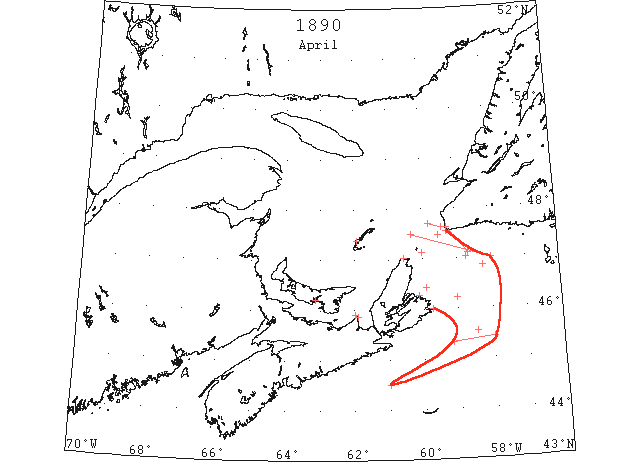
Apr 4 5 fields of ice and at noon same day 45°33’N 58°28’W a berg. (NYMR)
Apr 5 North Sydney, CB, ice in sight. (MH 07/04/1890 p3 #4)
Apr 8 The weather is clear and pleasant; but the cold nights are preventing the ice in the harbour from breaking up. (Pat 8 Apr p3#4)
Apr 9 A dispatch received Wednesday says that close packed ice, about 6 miles wide lies in the vicinity of the Magdalen Islands, and that the ice in the vicinity of Meat Cove and Cape Ray is closely packed. Fifteen schooners have cleared for the seal fisheries. Seals, however, are reported scarce. (MH 11/04/1890 p3 #1)
Apr 11 North Sydney, CB, the steamship “Strait of Gibraltar,” previously reported at Louisburg, is considerably damaged by ice. On one bow there is a hole about fourteen feet by eight; and on the other bow several plates are broken. The steamer has been grounded to prevent sinking. It is expected that she will repair there and proceed to New York. (MH 12/04/1890 p3#2)
Apr 17 Steamer “Lake Nepigon” (Br), at Montreal from Liverpool, reports, encountered a field of pack ice off Cape Ray, NF, and for six days without a chance of escape she was at the mercy of the ice in which she became tightly jammed. Finally the ice began to shove under the ship, she began to careen and was in danger of capsizing and almost a panic ensued among the emigrants, but at the critical moment the jam ceased and the steamer was once more in the water. She got nipped again on Apr. 22 and was cut out by the sailing steamer :Samson”. (NYMR, p.2, col.4).
Apr 17 Bark “Panther”: While cruising in the southeastern portion of the Gulf of St. Lawrence and off the SW coast of Newfoundland met very heavy field ice in which we frequently got jammed. The ice was never out of sight and the last seen was on the 17th in 46°51’N 58°14’W. The general movement of the ice was southward. (HB #35 May 2)
Apr 17 Low Point, CB, no drift ice in sight. (MH 18/04/1890 p3 #5)
Apr 18 Canso, arrived, stmr “Rimouski”, schrs “Huntress,” bound to Magdalen Islands (lost both anchors and chain and damaged cutwater in ice in gale of 6). (MH 22/04/1890 p3#3)
Apr 20 Field ice 45°20’N 59°10’W. (MWR Apr.96.1)
Apr 20-24 Montreal, the steamer “Lake Nepigon,” which arrived in port yesterday had a thrilling experience in the ice. She left Liverpool on the 11th April. The first ice sighted was a large berg, about four miles off, on the 18th. On the 19th she met a large field of ice and the engine was slowed down for a time. The field ice was in sight all day. On the 20th Cape Race was sighted. On the first a dense ice field extending outward from the land was sighted and the engines had to be slowed down and occasionally stopped. Cape Ray was sighted at 4 p.m., the light house keeper reporting the light house at Magdalen Islands is operation. At 9 o’clock a dense ice field was entered, the engines being stopped and the ship lying to until daylight. Snow fell at midnight. The morning of the 22nd was spent ploughing a passage through heavy field ice. At 7:30 the sealing vessel “Samson” was spoken, and at 8:30 the second office and three sailors came aboard, walking across the ice, and advised the captain to run around and go back to clear water, reporting closely packed ice up the gulf as far as they could see. This was done, Cape Ray being reached on the 23rd, after ploughing through dense field ice. The voyage was resumed on the 24th, the ship being worked around the edge of the field, and the engines put at full speed. At 5:30 there was a heavy swell. At 10:40 field ice ahead was reported, necessitating the slowing down of the engines. The ship laid to for the night. The rest of the trip was a succession of ploughing through field ice, with frequent stoppages. The “Lake Nepigon” had plenty of provisions on board, and there was very little anxiety, considering the circumstances, displayed by passengers. Other vessels arriving also report sharp encounters with ice. (MH 02/05/1890 p3 #2)
Apr 20,25 SS “Portia” 45°20’N 59°10’W large ice fields containing some heavy northern ice. Steamed to eastward through loose ice for 50 mils. 45°25’N 58°W several patches heavy ice. Steamed through loose ice for 4 hours to westward and left a large ice field on the NW side of us. (HB #35 May 2)
Apr 21 47°02’N 58°43’W large field of broken ice; Cape Ray bearing east, 6m, another very large field of ice; after the first 15m, ice grew much thicker and more closely packed and rafted; communicated with a steam sealer which reported ice as far as could be seen from aloft; 24th, failed to make further progress and returned to open water; while cruising off Cape Ray, found the ice breaking up fast and drifting southeasterly; 27th, steered west from Cape Ray through broken and loose ice; entered clear water, St. Paul’s bearing southwest by south, 18m. (MWR)
Apr 21 On account of large quantities of ice on the Cape Breton coast, the steamer “St. Pierre” will not sail to-night for Sydney and Cow Bay as advertised, but will sail next Monday the 23rd inst, for St. Pierre direct. Captain Angrove, of the steamer “St. Pierre” which arrived last night from St. Pierre reports was bound to Cow Bay, but found heavy ice for 30 miles off the Cape Breton coast, and up to Scattarie. He states that he never saw as heavy ice so far south before. (MH21/04/1890 p3#1)
Apr 23 The ice at Cape Rouge is moving out of the St. Lawrence River. A telegram from Quebec stated that the “Lake Nepigon” was fast in the ice off Cape Ray. (MWR Apr.96.1)
Apr 23 Low Point, CB, clear, strong SW, ice distant, moving east. Port Mulgrave, arrived, stmr “Princess Beatrice,” Halifax, and sailed for Souris. Passage clear of ice. … “Restive,” Boston for Port Hastings, lost rudder in the ice; was towed in here by steamer “Princess Beatrice. (MH 24/04/1890 p3#4)
Apr 24 Port Hastings, CB, strait clear of ice. (MH 26/04/1890 p3 #4)
Apr 24 Meat Cove, CB, strips of ice six miles wide, moving SE; fresh S W wind. Magdalen Islands clear of ice. Quebec, Cape Rouge bridge broken, Straits of Northumberland and Gut of Canso clear of ice. Cape Ray, NF, Heavy open ice, distant. Steamer “Nipigon: off there 6:30 p.m. yesterday. (MH 25/04/1890 p3 #1)
Apr 25 45°25’N 58°W field ice; [SS “Wisconsin from Liverpool to New York] The Bark “Maitland” from Buenos Ayres for Sydney, CBI, was prevented from getting within 50m of Sydney by ice and had to put in at Halifax. (MWR)
Apr 26 Halifax, arrived, Norwegian barque “Maitland” Bergen, was bound to Sydney, but could not get within 50 miles of that port on account of ice. (MH 26/04/1890 p3 #4)
Apr 27 47°07’N 60°W field ice; 44°30’N 61°W field ice. (MWR).
Apr 27 SS “Grecian” At entrance to Gulf of St. Lawrence from 58°W to 60°20’W passed very large fields of ice. (HB #36 May 9)
Apr 28 Off Cape George, loose field ice extending ~4m SW; 47°06’N 58°40’W to Cape Ray, field ice; [SS “City of Berlin (MWR)
Apr 28 Low Point, CB, ice heavy, open east; no ice north. (MH 29/04/1890 p3 #4)
Apr 29 [SS “City of Chester” from Liverpool to New York] at entrance of the Gulf of St. Lawrence from 58°W to 60°20’W very large field of ice. (MWR)
Apr 29 Low Point, CB, ice distant heavy open moving northeast. (MH 30/04/1890 p3 #4)
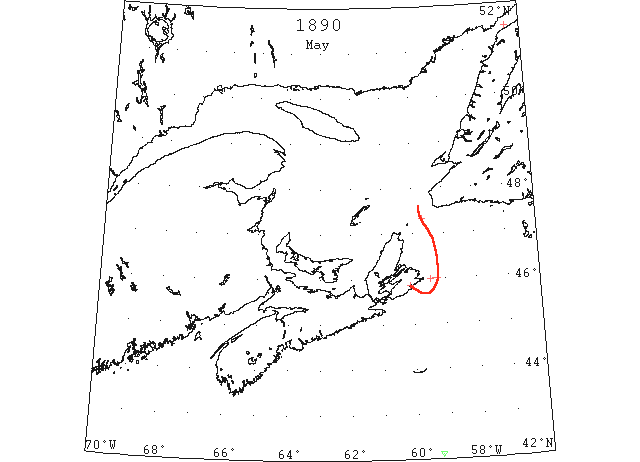
May During the early part of the month Gulf ice was reported between Cape Breton Island and Newfoundland. (MWR May 123.1)
May 2 SS “Alaska” entered field ice about 20 miles E of Scatari. Passed through about 10 miles of loose, broken ice. (HB #37 May 16)
May 6 North Sydney, the American fishing schooner “Lucy W Dwyer”, Portland, arrived from the fishing grounds this morning. She has been fishing on the Western Bank, Bank Quereau, Bank of St. Pierre, and Green Bank. The captain reports having seen no ice in the gulf since May 1. (MH 07/05/1890 p3 #5)
May 10 The southern coast of Cape Breton has been completely blocked with ice during the past three weeks and at present date there are eighteen vessels ice-bound in Gabarus harbor. Old fishermen prophesy an unusually late spring on this shore. Lobster fishermen are completely discouraged on account of this drawback. At Arichat and Canso factories have been running since early in April and in Yarmouth some were in active operation March 10th, while on this coast there is little likelihood of starting before late in the present month. (MH 10/05/1890 p3 #1)
May 11 42°07’N, 59°17’W, an iceberg. (NYMR, p.2, col.4).
May 13 56°08’W, an iceberg. A steamer burning night signal, green and red lights simultaneously, bound W. (NYMR, p.2, col.4)
May 28 A report of the 28th stated that the Straits of Belle Isle were solidly packed with ice. (MWR May 123.1)
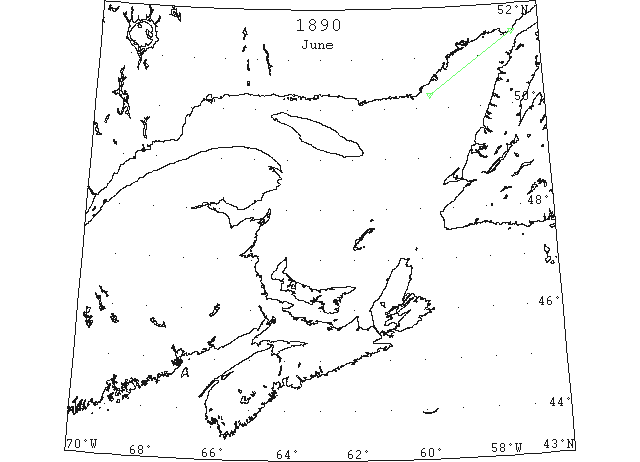
Jun “.. from Belle Isle to Point Amour there were numerous large icebergs thickly packed with small pieces of ice; and icebergs were observed 126 miles from Point Amour on a course to Heath Point, Anticosti Island. (MWR Jun.149.2)